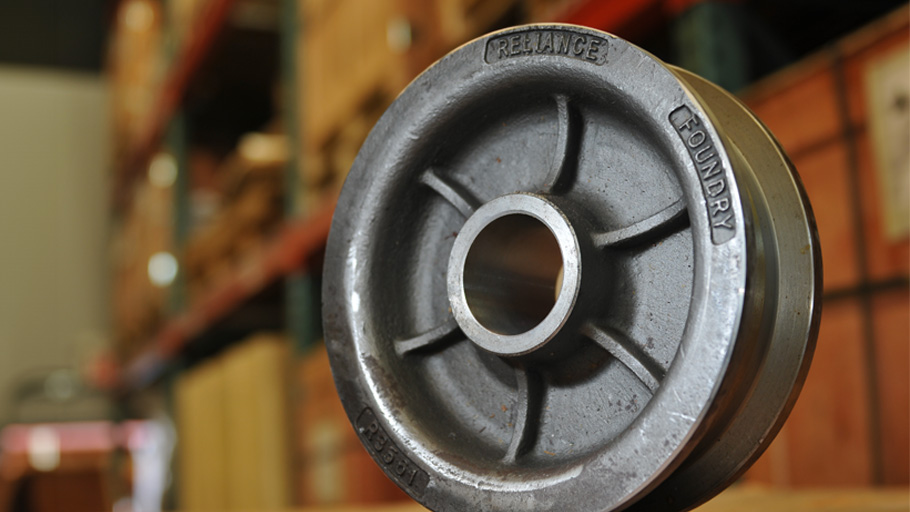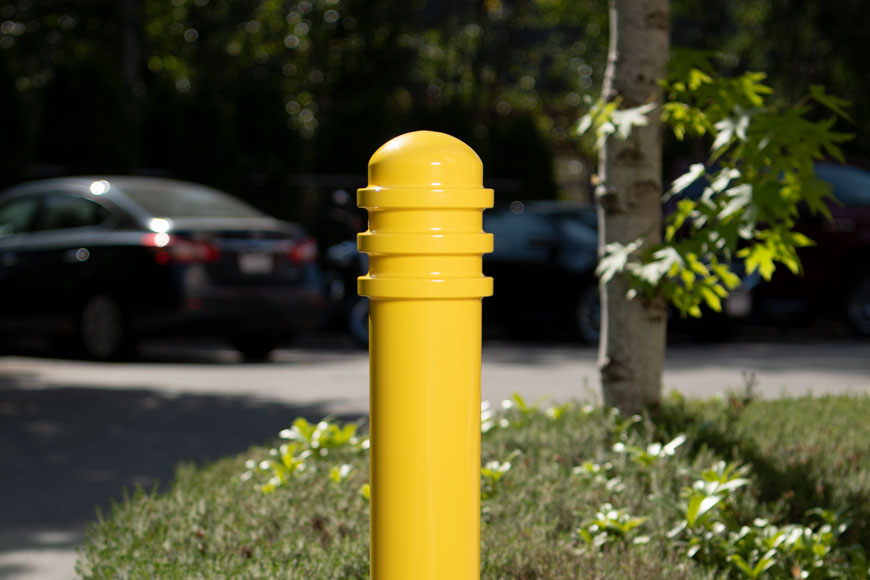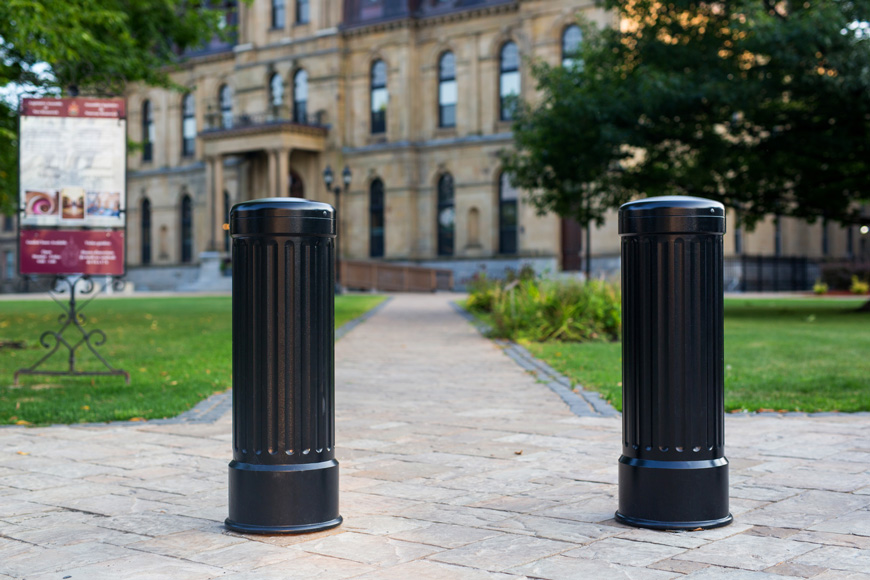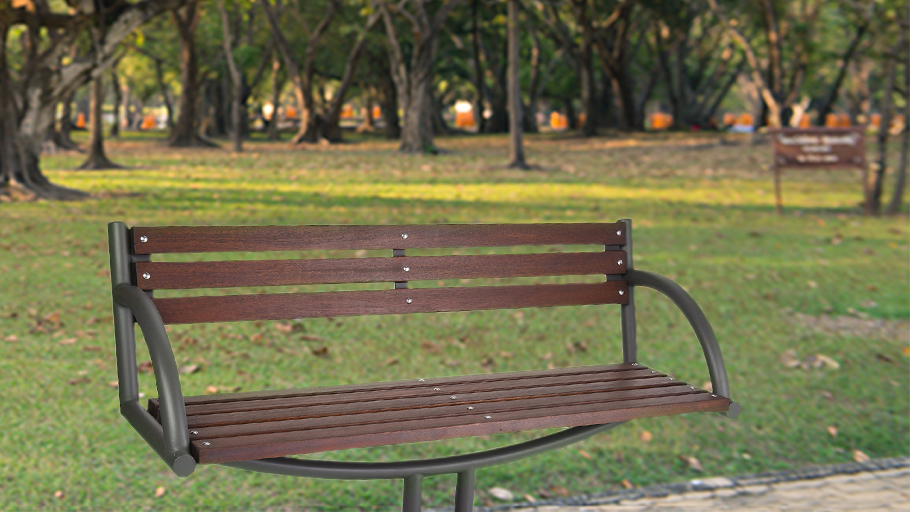Bollards define space and provide security measures—with aesthetic appeal
Every year in the United States, there are about 20,000 incidences of vehicles crashing into bus stops, offices, shopping malls, restaurants, and other storefronts.i Over the past few years, there have also been numerous vehicle ramming attacks around the world. Though the circumstances vary, the numbers are alarming—and cars aren’t going anywhere.
Bollards are a simple, practical, and cost-effective way to protect pedestrians, cyclists, property, and other vehicles from crashes like these, whether intentional or accidental. They provide visual cues to both drivers and pedestrians, guiding traffic and increasing awareness. When needed, they also provide a protective physical barrier—without invoking the look and feel of a fortress.
Bollards and aesthetics
Though bollards are usually primarily installed to increase security, they can also be used as design features, functioning as landscaping elements. And that’s not all—bollards can also serve many other purposes:
- Create visible boundaries of a property
- Separate areas within sites
- Control or guide traffic
- Permit pedestrian access while preventing entry of vehicles
Removable and operable (fold-down and retractable) bollards can allow different levels of access restriction for a variety of circumstances. They frequently tell us where we can and cannot drive, park, bike, or walk.
Bollards also include the following benefits:
- Aesthetic appeal to building exteriors and surrounding areas
- Lighting
- Security cameras
- Bicycle parking
- Seating

Decorative bollards are made in a variety of patterns to harmonize with a wide range of architectural styles. The prevalence of the most basic form of security bollard—the concrete-filled steel pipe—has encouraged the manufacturing of architectural bollards designed to fit as covers over standard steel pipe sizes, adding pleasing form to the required function.
What is a Bollard?
A bollard is a short vertical post. Early bollards were for mooring large ships at dock, and they are still in use today. A typical marine bollard is produced in cast iron or steel and shaped somewhat like a mushroom—the enlarged top is designed to prevent mooring ropes from slipping off.

Today, the word bollard also describes a variety of structures used on streets, around buildings, and in landscaping. According to legend, the first street bollards were actually cannons—sometimes said to be captured enemy weapons planted in the ground as boundary posts and town markers. When the supply of former cannons was used up, similarly shaped iron castings were made to fulfill the same functions. Bollards have since evolved into many varieties that are widely employed on roads, especially in urban areas, as well as outside supermarkets, restaurants, hotels, shops, government buildings, and stadiums.
Common permanent bollards
The most common type of bollard is fixed. The simplest version is an unadorned steel post, about 36 to 48 inches tall. Specially manufactured bollards include not only simple posts, but also a wide variety of decorative designs. Some feature square or rectangular cross-sections, but most are cylindrical, sometimes with a domed, angled, or flat cap. They come in a variety of metallic, painted, and durable powder coat finishes.
Removable bollards
Removable bollards are used where the need to limit access or direct traffic changes. Both retractable and fold-down styles are employed where selective entry is frequently needed, and are designed so the bollard can be easily collapsed to ground level and quickly re-erected. Both retractable units may be manually operated or automated with hydraulic movements.
Movable bollards
Movable bollards are large, heavy objects—frequently stone or concrete—that rely on their weight rather than structural anchoring to stay in place. They are designed to be moved rarely, and then only with heavy machinery such as a forklift.
Applications for bollards
Bollards generally fall into three types of applications:
- Decorative (architectural/landscaping highlights)
- Safety and traffic direction
- Security (impact-resistant)
Decorative Bollards
Some bollards are intended purely to be an ornament. As stand-alone architectural or landscaping features, they can border, divide, or define a space. They can also be accents, sentries, or supporting players to larger, more dramatic architectural gestures.
Decorative bollards are manufactured to harmonize with both traditional and contemporary architectural styles. The latter lean toward visual simplicity—often straight-sided posts with one or more reveals near the top. Styles made to match various historic periods usually have more elaborate shapes and surface details. These include flutes, bands, scrolls, and other ornamentation.
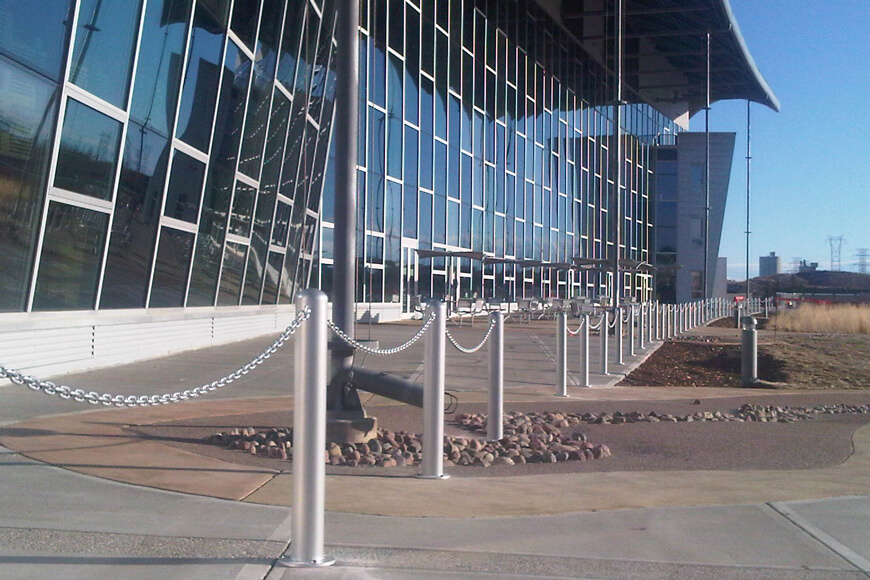
The post-top
The post-top is a distinctive feature. Traditional bollard design often includes elaborate decorative finials, whereas contemporary versions frequently feature a simple rounded or slanted top to deter passersby from leaving trash or using them for impromptu seating. On the other hand, they are sometimes made flat and broad specifically to encourage seating. Common decorative bollard materials include iron, aluminum, stainless steel, and concrete.
Ornamental designs
Ornamental designs with elaborate detail are frequently made of iron or aluminum casting. Aluminum bollards are desirable for applications where weight is an issue, such as a removable bollard. Aluminum units tend to be slightly more expensive than iron. For applications where a decorative bollard may be subject to destructive impact, ductile iron is a safer choice than more brittle metals, as force will deform the metal rather than shatter it into hazardous projectiles.
Iron and aluminum
Iron and aluminum bollards are frequently manufactured by sand-casting—a traditional foundry technique that is economical and well-suited to objects this size. However, sand-cast objects frequently bear surface irregularities that tend to leave the finished product less appealing to the eye. If high-finish consistency is desired, seek a manufacturer that will machine 100% of the surface after casting to produce units with a uniform surface for maximum visual appeal.
Finish in a decorative bollard
Finish is an important consideration in a decorative bollard, from functional as well as aesthetic standpoints. Bollards are, by their nature, prone to being scratched or nicked by pedestrians and vehicles. Those located near roadways are exposed to a fairly aggressive environment—petrochemical residues and splashes of diluted road de-icing salts may compromise some painted finishes.
Moderately aggressive environments
- Factory-applied powder coating finish is ideal
- Available for iron, aluminum, and steel
- This application process builds up a coating with very consistent coverage
- During coating, any bare metal attracts the powder, eliminating pinholes in coverage
- The baking process that completes the finish gives it additional toughness and abuse resistance
Harsh environments
- Aluminum bollards are a better choice than iron
- If the finish coat is damaged, aluminum oxidizes to a color that is more acceptable than the red rust produced by iron
- Aluminum and stainless steel are also available in several bare metal finishes
Functionality in a decorative bollard
Functionality can be added to the otherwise decorative bollard. One common option is the chain eye—linking two or more bollards with a chain, creating a simple traffic direction system. A large metal loop or arm on the side of the post allows parking and locking of bicycles, an increasingly popular choice as more people seek alternative green transportation. Bollards may also contain lighting units or security devices, such as motion sensors or cameras.
Traffic and Safety
The most common bollard applications are traffic direction and control, along with safety and security.
Traffic direction & control
Primary functions:
- Visual deterrence
- Stopping accidental breach of a defined space
Safety & security
Primary functions:
- Impact resistance
- Stopping intentional ramming
Closely spaced lines of bollards can form a traffic filter, separating motor vehicles from pedestrians and bicycles. For example, placing the posts with 3 feet (1 meter) of clearance between them allows easy passage for humans and human-powered vehicles—such as wheelchairs or shopping carts—but prevents the passage of cars. Such installations are often seen in front of the parking lot entrance to a store, and at the mouths of streets converted to outdoor malls or walking streets. In designing bollard installations for a site, care must be taken to avoid locating them where they will become a navigational hazard to authorized vehicles or cyclists.
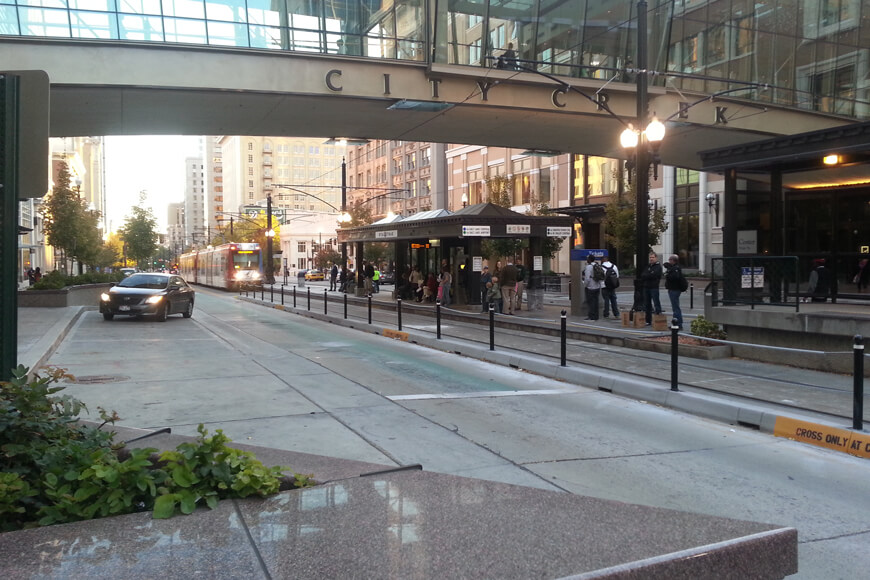
Some applications for traffic guidance depend on the cooperation of drivers and pedestrians and do not require impact resistance. A line of bollards linked by a chain presents a visual cue not to cross the boundary, even though it may be easy enough for a pedestrian to go over or under the chain if they choose. Bollards designed to direct traffic are sometimes made to fold, deflect, or break away on impact.

Adding greater collision resistance allows a bollard to enforce traffic restrictions instead of merely suggesting them. Plain pipe bollards are frequently placed at the corners of buildings, or flanking lamp-posts, public phones, fire hydrants, gas pipes, and other installations that need to be protected from accidental contact.
A bollard at the edge of a roadway prevents cars from mounting sidewalks and harming pedestrians. Bell-shaped and similarly designed bollards (such as the Martello bollard) can redirect a vehicle back onto the roadway when its wheels hit the bollard’s sloped sides. They are employed where U-turns and tight-radius turns are frequent. This kind of usage is particularly common at corners where vehicle drivers often misestimate turns, and pedestrians are especially close to the roadbed waiting to cross. In some cities, automatically retractable impact-resistant bollards are installed to regulate the flow of traffic into an intersection.
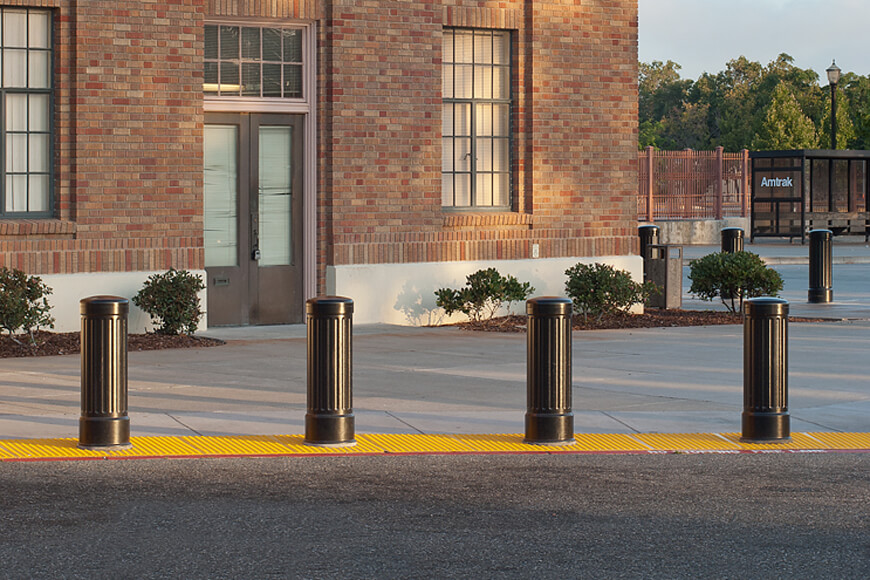
Security
The aftermaths of the 1995 Oklahoma City bombing, the September 11 attacks, and the more recent terror attacks in Western Europe all saw a sharp rise in the installation of bollards for security purposes. Vehicle-ramming attack protection not only include security bollards and posts, but other concrete and metal barriers designed to resist impact without presenting the appearance of a protective barrier—such as large planters or benches that conceal bollards.
Calculating resistance
Once the design threat is determined, the resistance needed to stop it can be calculated. Specification of anti-ram perimeter considers both the mass and the speed of an approaching attack vehicle, with the latter being considered the more significant.
According to Weidlinger Associates principal, Peter DiMaggio, an expert in security design, careful assessment of the surrounding site is required.
“Street and site architecture will determine the maximum possible approach speed,” he said. “If there are no approaches to the building with a long run-up, an attack vehicle cannot build up high speed, and the resistance of the anti-ram barriers can be adjusted accordingly.”
ANTI-RAM, CRASH-RATED BOLLARDS
Common anti-ram, crash-rated bollards include the C40, M30, and M50 models. Each of these models is used to provide a different level of resistance.
- C40 bollards stop a compact car moving at 40 miles per hour.
- M30 bollards stop a midsize truck moving at 30 miles per hour.
- M50 bollards stop a midsize truck moving at 50 miles per hour.
Other ratings are available, for slower speeds and for heavier vehicles. Most are rated to a P1 penetration rating, which means they are able to stop a vehicle hitting head-on so that the chassis of the vehicle does not travel more than 3.3 feet over the barrier line.
Security bollards
The simplest security bollard is a piece of 8 in (203 mm), 10 in (254 mm), or 12 in (305 mm) carbon steel structural pipe. Some impact resistance is achieved even with a 4 in (102 mm) pipe, depending on the engineering of its foundation. It is often filled with concrete to increase stiffness, although an unfilled pipe with plate stiffeners inside may produce better resistance in the same diameter pipe. Without any form of internal stiffening, the pipe’s wall-thickness needs to be significantly greater. For fixed-type security bollards, simple pipe bollards may be functionally sufficient, if properly mounted. Undecorated pipe-type bollards are also specially manufactured.
Enhancing the look of security bollards
The biggest disadvantage of a plain pipe bollard is aesthetics. A piece of painted pipe does not truly blend into—much less enhance—most architectural schemes. However, this can be overcome by a decorative bollard cover. Many standalone bollards that do not have impact-resistance of their own are designed with alternative mounting capability to slip over standard pipe sizes, forming an attractive and architecturally appropriate impact-resistance system. These decorative covers may also be available to enhance specially designed (but non-decorative) pipe-type bollards.
Bollard Mountings
There are three basic types of bollard mountings: fixed, removable, and operable (retractable or fold-down).
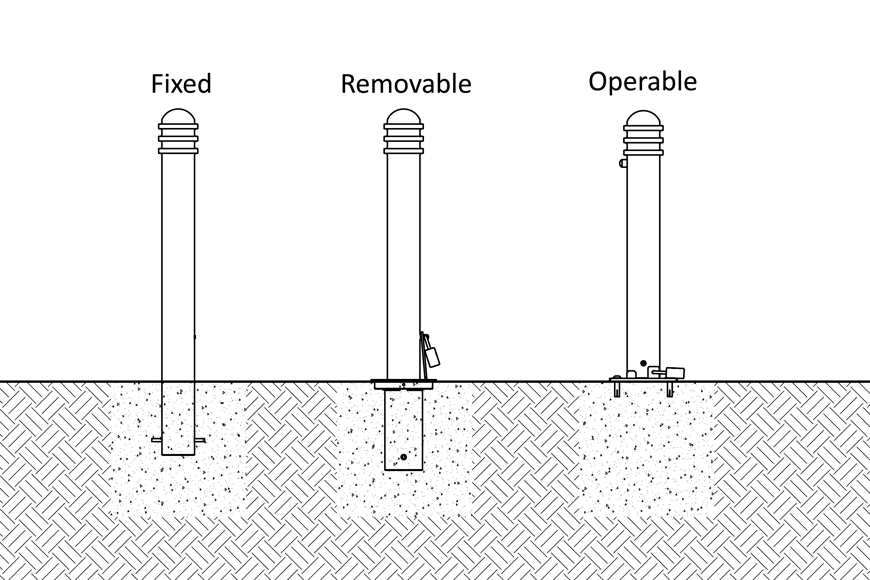
Fixed bollards
Fixed bollards can be mounted into existing concrete, or installed in new foundations. Manufactured bollards are frequently designed with their own mounting systems. Standalone mountings can be as non-invasive as drilling into existing concrete and anchoring with epoxy or concrete inserts. Such surface-mounted bollards can be used for purely aesthetic installations and substantial visual deterrence and direction, but provide only minimal impact resistance.
Bollards designed to protect against impact are usually embedded in concrete several feet deep, if site conditions permit. Engineering of the mounting depends on design threat, soil conditions, and other site-specific factors. Strip footings that mount several bollards provide better resistance, spreading the impact load over a wider area. For sites where deep excavation is not desirable or possible (e.g. an urban location with a basement or subway beneath the pavement), bollards made with shallow-depth installation systems are available for both individual posts and groups of bollards. In general, the shallower the mounting, the broader it must be to resist impact loading.
Removable bollards
A removable bollard typically has a permanently installed mount or sleeve below grade, while the sleeve’s top is flush with the pavement. The mating bollard can be manually lifted out of the mount to allow access. This system is intended for locations where the change of access is occasionally needed. It can include a locking mechanism, either exposed or concealed, to prevent unauthorized removal. Both plain and decorative bollards are available for this type of application. Most removable bollards are not designed for high-impact resistance and are usually not used in anti-ram applications.
Retractable bollards
Retractable bollards telescope down below pavement level, and may be either manual or automatically operated. Manual systems sometimes have lift-assistance mechanisms to ease and speed deployment. Automatic systems may be electric or hydraulic, and sometimes include a dedicated backup power installation so the bollard remains functional during emergencies. Retractable systems tend to be unornamented.
Bollards in the modern world
Bollards are as ubiquitous as they are overlooked. They speak to the need for defining space, one of the basic tasks of the modern built environment. Decorative bollards and bollard covers offer a versatile solution for bringing pleasing form to a variety of functions. The range of available options is vast in terms of both visual style and performance properties. For security applications, a design professional with security expertise should be included in the planning team.
i Storefront Safety Council. “Storefront Safety Initiative”.




